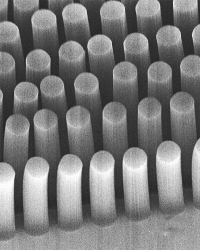According to Mehmet Toner, professor of biomedical engineering at Harvard Medical School and a member of the Harvard-MIT Division of Health Sciences and Technology, the microfluidic product, which has been described in the March 17 online issue of the journal Small, looks like a dime.
It will also help trace viruses like HIV. It could also enable cost- efficient diagnostic tests in developing countries.
 HST-MIT's Nanotube Assembly
HST-MIT's Nanotube Assembly
Cancer cells that have escaped from the original tumour are difficult to track because they are limited in number. However, detecting these breakaway cells is important in determining whether a cancer has metastasized or not.
Carbon nanotubes are nano-sized hollow cylinders having walls that are carbon atom lattices. The assembled tubes are porous, with less than 1% carbon and 99% air. Each assembly comprises 10 to 100 billion nanotubes/sq.cm. This allows fluid to flow through it.
Different patterns of nanotube assemblies were placed in the microfluidic tool. Each tube surface was coated with antibodies suitable for particular cancer cells. The fluid flows through and around the assemblies, so that the target cells or particles can be trapped. The device can coat different antibodies to the nanotube surfaces and change the spaces between them to allow the capture of differently-sized particles from tumour cells to viruses.
Source: http://hst.mit.edu/